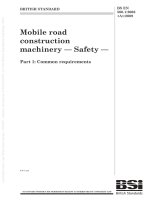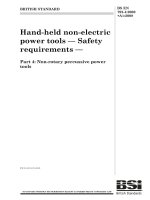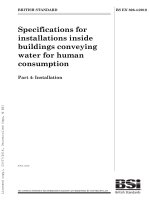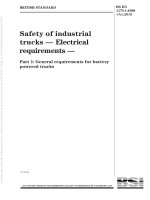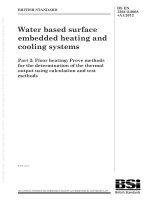Bsi bs en 62439 4 2010 + a1 2012
Bạn đang xem bản rút gọn của tài liệu. Xem và tải ngay bản đầy đủ của tài liệu tại đây (1.45 MB, 46 trang )
BS EN 62439-4:2010+A1:2012
BSI Standards Publication
Industrial communication
networks — High availability
automation networks
Part 4: Cross-network Redundancy Protocol (CRP)
BRITISH STANDARD
BS EN 62439-4:2010+A1:2012
National foreword
This British Standard is the UK implementation of EN 62439-4:2010+A1:2012.
It is identical to IEC 62439-4:2010+A1:2012. It supersedes
BS EN 62439-4:2010, which is withdrawn.
The UK participation in its preparation was entrusted to Technical Committee
AMT/7, Industrial communications: process measurement and control,
including fieldbus.
A list of organizations represented on this committee can be obtained on
request to its secretary.
This publication does not purport to include all the necessary provisions of a
contract. Users are responsible for its correct application.
© The British Standards Institution 2012. Published by BSI Standards
Limited 2012.
ISBN 978 0 580 73808 1
ICS 25.040.40; 35.040; 35.110
Compliance with a British Standard cannot confer immunity from
legal obligations.
This British Standard was published under the authority of the Standards
Policy and Strategy Committee on 30 June 2010.
Amendments/corrigenda issued since publication
Date
Text affected
31 May 2012
Implementation of IEC amendment 1:2012 with CENELEC
endorsement A1:2012. Clause 8.4.1.1 and Table 7 have been
amended.
EN 62439-4:2010+A1
EUROPEAN STANDARD
NORME EUROPÉENNE
EUROPÄISCHE NORM
April 2012
ICS 25.040; 35.040
English version
Industrial communication networks High availability automation networks Part 4: Cross-network Redundancy Protocol (CRP)
(IEC 62439-4:2010)
Réseaux de communication industrielle –
Réseaux d’automatisme à haute
disponibilité –
Partie 4 : Protocole de redondance
transréseau (CRP)
(CEI 62439-4:2010)
Industrielle Kommunikationsnetze Hochverfügbare Automatisierungsnetze Teil 4: Redundanz-Protokoll
für vermaschte Netze (CRP)
(IEC 62439-4:2010)
This European Standard was approved by CENELEC on 2010-03-01. CENELEC members are bound to comply
with the CEN/CENELEC Internal Regulations which stipulate the conditions for giving this European Standard
the status of a national standard without any alteration.
Up-to-date lists and bibliographical references concerning such national standards may be obtained on
application to the Central Secretariat or to any CENELEC member.
This European Standard exists in three official versions (English, French, German). A version in any other
language made by translation under the responsibility of a CENELEC member into its own language and notified
to the Central Secretariat has the same status as the official versions.
CENELEC members are the national electrotechnical committees of Austria, Belgium, Bulgaria, Croatia, Cyprus,
the Czech Republic, Denmark, Estonia, Finland, France, Germany, Greece, Hungary, Iceland, Ireland, Italy,
Latvia, Lithuania, Luxembourg, Malta, the Netherlands, Norway, Poland, Portugal, Romania, Slovakia, Slovenia,
Spain, Sweden, Switzerland and the United Kingdom.
CENELEC
European Committee for Electrotechnical Standardization
Comité Européen de Normalisation Electrotechnique
Europäisches Komitee für Elektrotechnische Normung
Central Secretariat: Avenue Marnix 17, B - 1000 Brussels
© 2010 CENELEC -
All rights of exploitation in any form and by any means reserved worldwide for CENELEC members.
Ref. No. EN 62439-4:2010 E
BS EN 62439-4:2010+A1:2012
EN 62439-4:2010+A1:2012 (E)
-2-
Foreword
The text of document 65C/583/FDIS, future edition 1 of IEC 62439-4, prepared by SC 65C, Industrial
networks, of IEC TC 65, Industrial-process measurement, control and automation, was submitted to the
IEC-CENELEC parallel vote and was approved by CENELEC as EN 62439-4 on 2010-03-01.
This EN 62439-4 together with EN 62439-1, EN 62439-2, EN 62439-3, EN 62439-5 and EN 62439-6
supersedes EN 62439:2008.
EN 62439-4:2010 includes the following significant technical changes with respect to EN 62439:2008:
– adding a calculation method for RSTP (rapid spanning tree protocol, IEEE 802.1Q),
– adding two new redundancy protocols: HSR (High-availability Seamless Redundancy) and DRP
(Distributed Redundancy Protocol),
– moving former Clauses 1 to 4 (introduction, definitions, general aspects) and the Annexes (taxonomy,
availability calculation) to EN 62439-1, which serves now as a base for the other documents,
– moving Clause 5 (MRP) to EN 62439-2 with minor editorial changes,
– moving Clause 6 (PRP) was to EN 62439-3 with minor editorial changes,
– moving Clause 7 (CRP) was to EN 62439-4 with minor editorial changes, and
– moving Clause 8 (BRP) was to EN 62439-5 with minor editorial changes,
– adding a method to calculate the maximum recovery time of RSTP in a restricted configuration (ring)
to EN 62439-1 as Clause 8,
– adding specifications of the HSR (High-availability Seamless Redundancy) protocol, which shares the
principles of PRP to EN 62439-3 as Clause 5, and
– introducing the DRP protocol as EN 62439-6.
Attention is drawn to the possibility that some of the elements of this document may be the subject of
patent rights. CEN and CENELEC shall not be held responsible for identifying any or all such patent
rights.
The following dates were fixed:
– latest date by which the EN has to be implemented
at national level by publication of an identical
national standard or by endorsement
(dop)
2010-12-01
– latest date by which the national standards conflicting
with the EN have to be withdrawn
(dow)
2013-03-01
Annex ZA has been added by CENELEC.
__________
BS EN 62439-4:2010+A1:2012
EN 62439-4:2010+A1:2012 (E)
-3-
Endorsement notice
The text of the International Standard IEC 62439-4:2010 was approved by CENELEC as a European
Standard without any modification.
In the official version, for Bibliography, the following notes have to be added for the standards indicated:
IEC 61158 series
NOTE Harmonized in EN 61158 series (not modified).
IEC 62439-2
NOTE Harmonized as EN 62439-2.
IEC 62439-3
NOTE Harmonized as EN 62439-3.
IEC 62439-5
NOTE Harmonized as EN 62439-5.
IEC 62439-6
NOTE Harmonized as EN 62439-6.
__________
Foreword to amendment A1
The text of document 65C/672/FDIS, future edition 1 of IEC 62439-4:2010/A1, prepared by SC 65C,
"Industrial networks", of IEC TC 65, "Industrial-process measurement, control and automation" was
submitted to the IEC-CENELEC parallel vote and approved by CENELEC as EN 62439-4:2010/A1:2012.
The following dates are fixed:
•
•
latest date by which the document has
to be implemented at national level by
publication of an identical national
standard or by endorsement
latest date by which the national
standards conflicting with the
document have to be withdrawn
(dop)
2012-12-30
(dow)
2015-03-30
Attention is drawn to the possibility that some of the elements of this document may be the subject of
patent rights. CENELEC [and/or CEN] shall not be held responsible for identifying any or all such patent
rights.
Endorsement notice
The text of the International Standard IEC 62439-4:2010/A1:2012 was approved by CENELEC as a
European Standard without any modification.
BS EN 62439-4:2010+A1:2012
EN 62439-4:2010+A1:2012 (E)
-4-
Annex ZA
(normative)
Normative references to international publications
with their corresponding European publications
The following referenced documents are indispensable for the application of this document. For dated
references, only the edition cited applies. For undated references, the latest edition of the referenced
document (including any amendments) applies.
NOTE When an international publication has been modified by common modifications, indicated by (mod), the relevant EN/HD
applies.
Publication
Year
Title
IEC 60050-191
-
International Electrotechnical Vocabulary
(IEV) - Chapter 191: Dependability and quality
of service
-
IEC 62439-1
2010
Industrial communication networks - High
availability automation networks Part 1: General concepts and calculation
methods
2010
ISO/IEC 8802-3
2000
Information technology - Telecommunications and information exchange between systems Local and metropolitan area networks Specific requirements Part 3: Carrier sense multiple access with
collision detection (CSMA/CD) access method
and physical layer specifications
EN/HD
EN 62439-1
Year
-
–2–
BS EN 62439-4:2010+A1:2012
EN 62439-4:2010+A1:2012 (E)
CONTENTS
INTRODUCTION.....................................................................................................................6
1
Scope ...............................................................................................................................7
2
Normative references .......................................................................................................7
3
Terms, definitions, abbreviations, acronyms, and conventions .......................................... 7
4
3.1
3.2
3.3
CRP
5
CRP nodes .......................................................................................................................8
6
CRP LAN topology ...........................................................................................................8
7
CRP key components ..................................................................................................... 10
Terms and definitions ..............................................................................................7
Abbreviations and acronyms....................................................................................7
Conventions ............................................................................................................7
overview...................................................................................................................8
7.1
8
CRP general protocol operation............................................................................. 10
7.1.1 Doubly-attached nodes (DANCs) ............................................................... 10
7.1.2 Singly attached nodes ............................................................................... 11
7.2 CRP statistics........................................................................................................ 11
7.3 CRP Network_Status_Table .................................................................................. 12
7.4 CRP recovery time ................................................................................................ 15
7.4.1 Recovery time calculation .......................................................................... 15
7.4.2 Maximum repair time ................................................................................. 16
7.5 CRP multicast messages ....................................................................................... 16
7.5.1 Sending ..................................................................................................... 16
7.5.2 Receiving .................................................................................................. 16
7.6 CRP unicast messages ......................................................................................... 16
7.6.1 Sending a frame ........................................................................................ 16
7.6.2 Receiving a frame...................................................................................... 17
7.7 CRP redundancy information ................................................................................. 17
7.8 CRP redundancy statistics..................................................................................... 17
CRP protocol .................................................................................................................. 17
8.1
8.2
8.3
8.4
8.5
8.6
8.7
8.8
CRP singly attached node ..................................................................................... 17
CRP doubly attached node .................................................................................... 17
CRP Installation, configuration and repair ............................................................. 17
CRP LRE model attributes..................................................................................... 18
8.4.1 Attribute specification ................................................................................ 18
8.4.2 Impact of LRE configuration attributes ....................................................... 22
CRP encoding of the DiagnosticFrame .................................................................. 23
CRP Encoding of the AnnunciationFrame .............................................................. 24
CRP common protocol........................................................................................... 26
8.7.1 AnnunciationFrames .................................................................................. 26
8.7.2 DiagnosticFrames...................................................................................... 26
8.7.3 Detection of duplicate Node_Index ............................................................ 27
8.7.4 Detection of duplicate Node_Name............................................................ 27
8.7.5 Failure detection based on arrival of DiagnosticFrames ............................. 27
8.7.6 Status array entries ................................................................................... 28
8.7.7 Other failure detection ............................................................................... 28
CRP operational messages ................................................................................... 28
BS EN 62439-4:2010+A1:2012
EN 62439-4:2010+A1:2012 (E)
9
–3–
8.8.1 Load balancing .......................................................................................... 28
8.8.2 LAN and port maintenance ........................................................................ 28
8.8.3 Selecting transmission path ....................................................................... 29
8.8.4 Selecting reception adapter ....................................................................... 30
8.8.5 Crossed_cable_status ............................................................................... 30
8.8.6 Configured parameters .............................................................................. 30
8.9 CRP services ........................................................................................................ 31
8.9.1 Configuration options and services ............................................................ 31
8.9.2 LAN redundancy service specification ....................................................... 31
CRP Management Information Base (MIB) ..................................................................... 38
Bibliography.......................................................................................................................... 41
Figure 1 – CRP stack architecture ..........................................................................................8
Figure 2 – CRP single LAN topography ...................................................................................9
Figure 3 – CRP double LAN topology......................................................................................9
Figure 4 – CRP DiagnosticFrame pair approach ................................................................... 10
Figure 5 – CRP example system ........................................................................................... 11
Table 1 – CRP example Network_Status_Table for node 3 ................................................... 11
Table 2 – CRP Network_Status_Table for singly connected nodes........................................ 13
Table 3 – CRP Network_Status_Table for DANC .................................................................. 14
Table 4 – CRP Path_Status_Sets ......................................................................................... 21
Table 5 – CRP example of a Path_Status_Set ...................................................................... 21
Table 6 – CRP configuration attributes impact on LAN operation .......................................... 22
Table 7 – CRP DiagnosticFrame format ................................................................................ 23
Table 8 – CRP AnnunciationFrame ....................................................................................... 24
Table 9 – CRP unicast destination address handling............................................................. 29
Table 10 – CRP configuration parameters............................................................................. 30
Table 11 – CRP Set_Assignment_Info service parameters .................................................... 31
Table 12 – CRP Get_Redundancy_Info service..................................................................... 33
Table 13 – CRP Set_Redundancy_Info service ..................................................................... 35
Table 14 – CRP Get_Redundancy_Statistics service ............................................................ 37
–6–
BS EN 62439-4:2010+A1:2012
EN 62439-4:2010+A1:2012 (E)
INTRODUCTION
The IEC 62439 series specifies relevant principles for high availability networks that meet the
requirements for industrial automation networks.
In the fault-free state of the network, the protocols of the IEC 62439 series provide
ISO/IEC 8802-3 (IEEE 802.3) compatible, reliable data communication, and preserve
determinism of real-time data communication. In cases of fault, removal, and insertion of a
component, they provide deterministic recovery times.
These protocols retain fully the typical Ethernet communication capabilities as used in the
office world, so that the software involved remains applicable.
The market is in need of several network solutions, each with different performance
characteristics and functional capabilities, matching diverse application requirements. These
solutions support different redundancy topologies and mechanisms which are introduced in
IEC 62439-1 and specified in the other Parts of the IEC 62439 series. IEC 62439-1 also
distinguishes between the different solutions, giving guidance to the user.
The IEC 62439 series follows the general structure and terms of IEC 61158 series.
The International Electrotechnical Commission (IEC) draws attention to the fact that it is
claimed that compliance with this document may involve the use of a patent concerning a fullduplex Ethernet in which each device periodically transmits a message representing its
connectivity to the other devices , allowing them to choose a redundant path in case of failure,
given in 7.1 and 7.3.
IEC takes no position concerning the evidence, validity and scope of this patent right.
The holder of this patent right has assured the IEC that he/she is willing to negotiate licences
either free of charge or under reasonable and non-discriminatory terms and conditions with
applicants throughout the world. In this respect, the statement of the holder of this patent
right is registered with IEC. Information may be obtained from:
Fieldbus Foundation
9005 Mountain Ridge Drive – Bowie Bldg
Suite 190
Austin, TX 78759
USA
Attention is drawn to the possibility that some of the elements of this document may be the
subject of patent rights other than those identified above. IEC shall not be held responsible for
identifying any or all such patent rights.
ISO (www.iso.org/patents) and IEC ( maintain online data bases of patents relevant to their standards. Users are encouraged to consult the
data bases for the most up to date information concerning patents.
BS EN 62439-4:2010+A1:2012
EN 62439-4:2010+A1:2012 (E)
–7–
INDUSTRIAL COMMUNICATION NETWORKS –
HIGH AVAILABILITY AUTOMATION NETWORKS –
Part 4: Cross-network Redundancy Protocol (CRP)
1
Scope
The IEC 62439 series is applicable to high-availability automation networks based on the
ISO/IEC 8802-3 (IEEE 802.3) (Ethernet) technology.
This part of the IEC 62439 series specifies a redundancy protocol that is based on the
duplication of the network, the redundancy protocol being executed within the end nodes, as
opposed to a redundancy protocol built in the switches. The switchover decision is taken in
each node individually. The cross-network connection capability enables single attached end
nodes to be connected on either of the two networks.
2
Normative references
The following referenced documents are indispensable for the application of this document.
For dated references, only the edition cited applies. For undated references, the latest edition
of the referenced document (including any amendments) applies.
IEC 60050-191, International Electrotechnical Vocabulary – Chapter 191: Dependability and
quality of service
IEC 62439-1:2010, Industrial communication networks – High availability automation networks
– Part 1: General concepts and calculation methods
ISO/IEC 8802-3:2000, Information technology – Telecommunications and information
exchange between systems – Local and metropolitan area networks – Specific requirements –
Part 3: Carrier sense multiple access with collision detection (CSMA/CD) access method and
physical layer specifications
3
3.1
Terms, definitions, abbreviations, acronyms, and conventions
Terms and definitions
For the purposes of this document, the terms and definitions given in IEC 60050-191, as well
as in IEC 62439-1, apply.
3.2
Abbreviations and acronyms
For the purposes of this document, the abbreviations and acronyms given in IEC 62439-1,
apply, in addition to the following:
DANC Doubly attached node implementing CRP
SANC Singly attached node implementing CRP
3.3
Conventions
This document follows the conventions defined in IEC 62439-1.
BS EN 62439-4:2010+A1:2012
EN 62439-4:2010+A1:2012 (E)
–8–
4
CRP overview
This International Standard specifies a redundancy protocol that is based on the duplication of
the network, the redundancy protocol being executed within the end nodes, as opposed to a
redundancy protocol built in the switches. There is no central “redundancy manager”; instead
each node operates autonomously. The cross-network connection capability enables single
attached end nodes to be connected on either of the two networks.
5
CRP nodes
There exists different classes of nodes that may interoperate on the same network:
•
DANCs (Doubly Attached Nodes) able to execute the CRP protocol, and having two ports
for the purpose of redundancy.
•
SANCs (Singly Attached Nodes) able to execute the CRP protocol, and having only one
port.
•
SAN (Singly Attached Nodes), such as commercially available laptops or file servers that
are not aware of the CRP protocol. Even though not aware, SANs can also have access to
the redundancy management data for the purpose of monitoring and network management.
In DANCs, these two ports are referred to as port A and port B. They are managed by the Link
Redundancy Entity (LRE), whose implementation is not prescribed, and which is conceptually
located in the communication stack below the network layer, as illustrated in Figure 1.
upper layers
real-time
stack
UDP
TCP
IP
link redundancy entity
driver
driver
IEC 8802-3 MAC and PHY
IEC 8802-3 MAC and PHY
LAN_A
LAN_B
Figure 1 – CRP stack architecture
IEC
380/10
This arrangement provides application-level transparency. The LRE hides redundancy from
the upper layers and manages the ports. A node can therefore operate with only one IP
address.
6
CRP LAN topology
Implementing the redundancy protocol within the DANCs allows a variety of topologies, using
switches that are not aware of the redundancy protocol and could implement another
redundancy protocol such as RSTP.
This International Standard does not dictate the topology, but does allow for configuration of
node behaviour to accommodate the characteristics of the specific LAN being used.
Nodes may be attached to the same or to different switches of a single LAN, which may or
may not include redundant links, as Figure 2 shows. Attaching both links to the same switch
only provides leaf link failure resilience.
BS EN 62439-4:2010+A1:2012
EN 62439-4:2010+A1:2012 (E)
–9–
SAN
inter-switch link
leaf link
inter-switch port
switch
LAN
switch
switch
leaf link
edge ports
DANC
DANC
DANC
IEC
381/10
Figure 2 – CRP single LAN topography
Nodes may be attached to separate LANs, which are basically failure-independent, but may
be connected by an inter-LAN link, as Figure 3 shows.
DANC
SAN
A1
DANC
inter-LAN links
top switch
top switch
LAN_A
switch
DANC
LAN_B
switch
switch
SANC
A2
DANC
DANC
DANC
Figure 3 – CRP double LAN topology
switch
SAN
B1
SAN
B2
IEC
382/10
When there is only one LAN, a node is attached through both its ports to that LAN. In double
LAN configurations, port A is normally connected to LAN_A and port B to LAN_B. Connecting
a node twice to the same network tree or connecting port A to LAN_B and vice-versa may be
a configuration error called “crossed cables”.
– 10 –
7
BS EN 62439-4:2010+A1:2012
EN 62439-4:2010+A1:2012 (E)
CRP key components
7.1
7.1.1
CRP general protocol operation
Doubly-attached nodes (DANCs)
DiagnosticFrames are used to exercise communication paths and to assess the network
health. A DiagnosticFrame contains a summary of the reporting node’s view of the network
health and status, including its own port.
Annunciation frames are sent to announce the existence of the node. These frames are
described in 8.7.1
Each DANC sends a pair of DiagnosticFrames periodically, every T dmi , on both of its ports, as
Figure 4 shows. Each DANC that receives one DiagnosticFrame on one port expects the other
message of the pair on the other port. (On a single LAN, the node receives both messages on
both ports.) If a node receives no message or if it does not receive the second
DiagnosticFrame on the other port before receiving several more DiagnosticFrames on the
same port, it records a fault in the row of the Network_Status_Table for the corresponding
node.
Tdmi
node i
LAN A
LAN B
Tdmi
…
time
diagnostic messages
time
node j
IEC
383/10
Figure 4 – CRP DiagnosticFrame pair approach
In practice the receiving node compares the Sequence_Number of the last message received
on the other port with that just received. If the difference in Sequence_Number is more than
the configured Max_Sequence_Number_Difference, a fault is recorded.
Based upon the diagnostic frames it receives from all other nodes, each node can select
which port to use to send messages to a particular node, on a node-per-node basis.
EXAMPLE Figure 5 shows four nodes connected to two redundant LANs which are not connected with each other.
Node 3 and node 4 have link failures. The diagnostic frame handling on node 3 is detailed.
Each node broadcasts its view on the port status of all nodes it detected in addition to other status information
(source MAC address, Node_Index, etc.).
Node 3 maintains a Network_Status_Table populated by the DiagnosticFrames from nodes 1, 2, and 4, as shown in
Table 1.
The port status values are OK to indicate a working condition, and X for a don’t know or bad condition.
According to the first three columns of the Network_Status_Table in Table 1, node 3 sends out its
Received_DiagnosticFrame for port A as [OK, OK, OK, OK] and for port B as [OK, OK, OK, X].
Similarly, node 1 sends out its view on nodes 2, 3, and 4 as [OK, OK, X, OK] for port A and [OK, OK, OK, X] for
port B. Node 3’s adapter A and adapter B status is populated as shown in Table 1.
The row for node 3 is set based on its own testing, but in this example there is no testing, so all appears to be OK.
BS EN 62439-4:2010+A1:2012
EN 62439-4:2010+A1:2012 (E)
– 11 –
node
1
A
B
node
2
A
B
node
3
A
B
node
4
A
B
X
X
LAN A
LAN B
IEC
384/10
Node 3: Interface A partial failure; can receive, but not transmit
Node 4: Interface B complete failure.
Figure 5 – CRP example system
Table 1 – CRP example Network_Status_Table for node 3
Received_DiagnosticFrame
Node_Index
Number
Reported status extracted from
DiagnosticFrame
Received on
adapter A
Received on
adapter B
Node 3 Received
on adapter A
Node 3 Received
on adapter B
Received from
adapter A/B a
Received from
adapter A a /B
Received from
adapter A/B a
Received from
adapter A a /B
1
OK/X
X/OK
X/X
X/OK
2
OK/X
X/OK
X/X
X/OK
3 (this node)
OK/X
X/OK
OK/X
X/OK
4
OK/X
X/X
X/X
X/X
a
The cross statuses are all “X” for a dual LAN without inter-LAN link. That is, messages originating from a
port A are never heard on a port B and vice versa.
The DiagnosticFrames provide therefore:
•
minimal assurance of a working path. With each message received, the receiving node
can assume that its own receiver, the reporting node’s transmitter, and the path through
the network are all working;
•
assurance that the reverse path is working. With each message received, the receiving
node can extract the reporting node’s view of the receiving node and thus determine
whether its own transmitter, the reporting node’s receiver, and the path through the
network are all working.
This allows the system administrator to construct a variety of coverage strategies such as:
•
ensure that all paths between all nodes are tested;
•
send to a single node. This node may be a “diagnostic node” that only provides detection
of faults between each node and the diagnostic node.
7.1.2
Singly attached nodes
Singly attached nodes (SANCs) also can send and receive DiagnosticFrames. If they choose
to transmit them, the DANCs and SANCs are aware of their presence and attempt to ensure
that messages reach them. The Network_Status_Table built by the SANC allows it to build
DiagnosticFrames and also, in a single LAN, to select a path to a node with a failed port.
7.2
CRP statistics
Statistics should be gathered and presented for each port, by a system management
application. Examples of presentation methods are a graphical user interface for visual
reporting of network errors or via SNMP.
– 12 –
7.3
BS EN 62439-4:2010+A1:2012
EN 62439-4:2010+A1:2012 (E)
CRP Network_Status_Table
Each node maintains a Network_Status_Table that holds the node’s view of the network.
This table is used to assist with selection of which port(s) to use for transmission to a
destination address and which port(s) to use for reception of multicast transmissions.
The Network_Status_Table is constructed from received DiagnosticFrames as well as from
other locally acquired and sometimes vendor-specific diagnostic information, for example
built-in tests, link integrity pulse, etc.
This table is conceptual and is described to assist with understanding of the concepts in this
specification and no specific implementation is prescribed or implied. It is therefore not visible
to network management; however, the contents of the table are reflected in the
DiagnosticFrames.
The Network_Status_Table in each node keeps for each node, and in some cases for each
port of each node the following information:
a) for each remote reporting node,
•
remote node identification (name, index in a table, etc.);
•
diagnosis message interval;
•
apparent number of ports (1..N);
•
for each port, in nominal order (e.g., port to LAN_A before port to LAN_B) the MAC
address of the remote port.
b) for each pairing of local and remote ports (e.g., A/B, B/A, A/A or B/B)
•
time of latest message receipt;
•
sequence number of latest received message;
•
receipt of DiagnosticFrame from remote port within time;
•
remote port's link status from last received DiagnosticFrame.
c) for assessment of remote connectivity
•
inferred status of set of ports (functioning properly, cross-connected, ...);
•
preferred port pairing.
EXAMPLE
Table 2 shows a Network_Status_Table for a SANC and Table 3 a Network_Status_Table for a DANC.
7
6
LD003
5
4
LD001
3
FD002
2
FD001
1
Node_Index
and
Node_Name
1
2
1
1
5 000
5 000
5 000
1 000
2 000
2 000
1
1
Interval
(ms)
Number of
adapters
Reporting node information
Time
Time
Time
Time
Time
Time
Number
Number
Number
Number
Number
Sequence_
number of
last message
received
OK
OK
OK
OK
OK
Diagnostic
Frame received
OK
OK
OK
OK
OK
Reported status
extracted from
DiagnosticFrame
for AA
Messages received here sent from reporting node’s adapter A
Time
Time
Time
Number
Number
Sequence_
number of
Last
message
received
OK
OK
Diagnostic
Frame
received
OK
OK
Reported
status
extracted
from
Diagnostic
Frame for
BA
Messages received here sent from reporting node’s
adapter B
Table 2 – CRP Network_Status_Table for singly connected nodes
– 13 –
BS EN 62439-4:2010+A1:2012
EN 62439-4:2010+A1:2012 (E)
Sent from reporting node’s adapter A.
Sent from reporting node’s adapter A.
Sent from reporting node’s adapter B.
b
c
d
1
Messages received here on adapter B.
addr7.A
7
2
2
2
2
2
Number
of
adapters
a
addr6.A,
addr6.B
addr5.A,
addr5.B
addr3.A,
addr3.B
addr2.A,
addr2.B
addr1.A,
addr1.B
6
LD003
5
4
LD001
3
FD002
2
FD001
1
Node_Index
and
Node_Name
Addresses
for
adapters
A, B
Reporting node information
5 000
5 000
5 000
1 000
2 000
2 000
Interval
(ms)
OK
…
…
…
…
…
…
Ab
N/A
Time
Time
Time
Time
Time
Time
N/A
Number
Number
Number
Number
Number
Sequence_
Number of
last
message
received
N/A
OK
OK
OK
OK
OK
Diagnostic
Frame
received
N/A
OK
OK
OK
OK
OK
Reported
status
extracted
from
Diagnostic
Frame
for BA
Sent from reporting node’s adapter B
Messages received here on adapter A
Table 3 – CRP Network_Status_Table for DANC
NA
…
…
…
…
…
…
Ac
Ba
NA
…
…
…
…
…
…
Bd
OK
OK
OK
OK
OK
OK
Crossed_
cable_status
AA
BB
AA
AA
AA
BB
Selected
transmission
adapter and
receiving adapter
Assessment for reporting node
– 14 –
BS EN 62439-4:2010+A1:2012
EN 62439-4:2010+A1:2012 (E)
BS EN 62439-4:2010+A1:2012
EN 62439-4:2010+A1:2012 (E)
7.4
– 15 –
CRP recovery time
7.4.1
Recovery time calculation
The maximum recovery time from a fault is:
t rec = (1+Max_Sequence_Number_Difference) × t dmi + t path + t proc
where
t rec
is the recovery time;
t dmi
is the time interval of diagnostic frames;
t path
is the latency of frame delivery of the network; and
t proc
is the processing time of the receiving LAN redundancy entity.
The value of t path is determined by the amount of time the packet takes to travel through the
network. In a switched network the worst case transition time through a FIFO based switch is
dependent on the number of ports of the switch. It may be necessary to use QoS to respect
this delay. The arrival of the packet of interest after all other packets bound for the destination
interface of interest produces the worst case delay. In this case the delay is:
t sw = N ports × t rate × S pak × 8
where
t sw
N ports
t rate
S pak
is
is
is
is
EXAMPLE
the
the
the
the
delay time in a single switch;
number of switch ports on a single switch;
1/data rate; and
max packet size in bytes.
The following are examples of recovery time for various end node speeds.
Processing time is dominated by the interrupt response time of the end node. For this example an interrupt time of
15 μs is used.
Given: t dmi = 400 ms, t proc = 15 μs, Max_Sequence_Number_Difference = 1, N ports = 24 and S pak = 1 522 bytes for
all cases.
For all end nodes with 10 Mbit/s bandwidth:
t sw = 24 × 10 –7 × 1 522 × 8 = 0,029 s
In a single redundant LAN using 6 switches of 24 ports each, and assuming the diagnostic packet traverses all
switches, the total t path is 6 × t sw = 0,174 s.
Thus,
t rec = 2 × 0,40
+ 0,174 + 0,000 015 s
For this example the maximum processing time is negligible thus:
t rec = 0,974 s
For all end nodes with 100 Mbps bandwidth, the equation scales directly thus
t sw = 24 × 10 –8 × 1 522 × 8 = 0,002 9 s and for 6 paths = 0,014 6 s
– 16 –
BS EN 62439-4:2010+A1:2012
EN 62439-4:2010+A1:2012 (E)
Thus
t rec = 2 × 0,40 + 0,017 4 + 0,000 015
t rec = 0,817 4 s
7.4.2
Maximum repair time
For faults such as cable breaks there is no repair time. However, in a multiple interface switch
topology repairing a failed interface requires replacing the entire switch. In this case powering
the switch down to replace it causes additional network disruptions in nodes that have paths
though that switch. So as a worst case, the repair time is identical to the recovery time from a
fault described in 7.4.1.
7.5
7.5.1
CRP multicast messages
Sending
Multicast messages are always sent from both ports (if both are operational). They carry as
source MAC address the address of the port over which they have been sent.
This applies in particular to the DiagnosticFrames and AnnunciationFrames
7.5.2
Receiving
On some network topologies, a single operational multicast message can be received on each
of a node’s ports. If a node has two ports, the node may be configured to use the
Network_Status_Table to select a reception port for multicast operational messages, and so
reduce its interrupt and message processing load. Duplicates still need to be detected and
discarded.
7.6
7.6.1
CRP unicast messages
Sending a frame
Each unicast frame sent by a CRP redundancy participating node is sent from only one port.
When the LRE receives a frame from the IP stack (or other upper layer), it examines the
frame, identifies the destination MAC address and looks up for that address in the
Network_Status_Table.
If the A-A path to the destination is OK in the table, the LRE sends the frame to port A, which
inserts its address as a source MAC address.
If A-A path is NOT OK in the table, but the A-B path is OK, then the LRE substitutes the B
MAC address of the destination node in the frame and sends the frame to port A, which
inserts its address as a source MAC address.
If the A-A and A-B paths are both NOT OK, but the B-A path is OK, the LRE sends the frame
to port B, which inserts its address as a source MAC address.
If the A-A, A-B and B-A paths are NOT OK, the LRE substitutes the B MAC address of the
destination node in the frame and send the frame to port B, which inserts its address as a
source MAC address.
If the message is broadcast or multicast, the LRE sends the frame to A if A is working and to
B if A is not working.
BS EN 62439-4:2010+A1:2012
EN 62439-4:2010+A1:2012 (E)
7.6.2
– 17 –
Receiving a frame
When the LRE receives a frame from the physical layer over port B, it substitutes the
destination MAC B to MAC A address, before forwarding the frame up to the stack. Some IP
stacks are sensitive to the IP/MAC association being correct. The IP address is not
manipulated/substituted in any way on neither transmit nor receive.
7.7
CRP redundancy information
Each node is configured by a user definable mechanism. The configuration determines the
details of how each node transmits DiagnosticFrames and how it uses the
Network_Status_Table to select transmission and reception ports. This information can be
obtained from another node by listening to AnnunciationFrames.
7.8
CRP redundancy statistics
Any node (even if it is not CRP enabled) may gather and display the health of the nodes in the
network by subscribing to the multicast address used for the DiagnosticFrames. The
application may then generate a Network_Status_Table and use it in any way.
8
CRP protocol
8.1
CRP singly attached node
SANCs shall have one port and shall participate in the CRP redundancy protocol.
8.2
CRP doubly attached node
DANCs shall have two ports and participate in the CRP redundancy protocol.
8.3
CRP Installation, configuration and repair
DANC shall be connected to a single redundant LAN with redundant leaves or to a redundant
LAN without redundant leaves as described in Clause 6.
NOTE 1 The former connection provides four possible paths to other doubly connected nodes while the latter
provides only two.
In order to achieve switch and leaf link redundancy, each port of a DANC shall be connected
to a different switch.
SANC and SAN may be connected to any LAN, but preferably all SANCs and SAN shall be
connected to the same LAN.
The assigned Node_Index and Node_Name shall be unique in the network.
The maximum Node_Index is 2 048; the value of 0 shall not be used for Node_Index.
The maximum number of nodes is 2 047.
NOTE
2
This number is limited by the size of the array of status available in the diagnostic packet.
The maximum number of network switch layers of a single redundant LAN with redundant
leaves shall be 3.
NOTE 3 This limitation maintains a spanning tree diameter of 7 hops for those networks where spanning tree is
used to prevent loops.
– 18 –
8.4
BS EN 62439-4:2010+A1:2012
EN 62439-4:2010+A1:2012 (E)
CRP LRE model attributes
8.4.1
8.4.1.1
Attribute specification
Protocol_Version
This configured attribute specifies the CRP protocol used. It is an Unsigned8 with a value of
0x01 for the version without the optional extension field and 0x02 for the version with the
optional extension field.
Packets with higher version numbers shall be rejected by lower versions. Newer versions
shall revert to compatibility mode when older version packets are received.
8.4.1.2
Number_of_ports
This configured attribute specifies the number of ports on this node for the purpose of
redundancy (Unsigned8 = 1 or 2).
8.4.1.3
Max_Sequence_Number_Difference
This configured attribute specifies the maximum acceptable difference between the
Sequence_Number parameters in a pair of DiagnosticFrame received from a particular
sending node. It shall be an Unsigned8 greater than or equal to 1.
NOTE
This attribute affects the speed and accuracy of the dual message approach. The value of
Max_Sequence_Number_Difference number is at least one to ensure that faults are not detected by normal
incrementing of the Sequence_Number. A number of at least two ensures that a single lost message does not
cause detection of faults. Having larger numbers allows tolerance of the loss of several successive messages but
slows down speed with which the algorithm detects actual faults, as a trade-off between transient tolerance and
detection speed.
8.4.1.4
Redundancy_Flags
This configured attribute specifies five flags that are not transmitted, indicating one or more of
the following:
a) SingleMulticastMessageTransmissionEnabled. This defines the transmission policy for all
services with multicast destination addresses except for the DiagnosticFrame.
•
False
Transmit on both ports
•
True
Transmit on one port
b) CrossedCableDetectionEnabled.
•
False
Do not detect crossed cables
•
True
Detect crossed cables
c) SinglePortMulticastMessageReceptionEnabled. This defines the reception policy for all
multicast frames except for the DiagnosticFrame_Addresses for ports A and B.
•
False
Listen for multicast addresses on both ports
•
True
Listen for multicast addresses on one port except if a fault is detected
d) DiagnosisUsingOwnMessagesEnabled.
•
False
Do not use own DiagnosticFrames for diagnosis
•
True
Use own DiagnosticFrames for diagnosis
e) LoadBalancingEnabled.
•
False
Do not balance load
•
True
Balance load
BS EN 62439-4:2010+A1:2012
EN 62439-4:2010+A1:2012 (E)
8.4.1.5
– 19 –
DiagnosticFrame_Interval
This configured attribute specifies the time interval in milliseconds between successive
sending of the DiagnosticFrames as an Unsigned32.
NOTE This parameter is set individually for each end device. This allows tuning of the intervals to provide fast
detection of critical end devices while reducing the traffic from other end devices.
8.4.1.6
Ageing time
This configured attribute specifies the time interval in milliseconds used by the LRE to remove
silent nodes from its Network_Status_Table.
NOTE 1 The configuration ensures that the value of this attribute is larger than the value of the
Max_Sequence_Number_Difference attribute multiplied by the largest value of the DiagnosticFrame_Interval
attribute found in received DiagnosticFrames.
NOTE 2 Short ageing times (minutes) mean that DANCs appear and disappear if their power fails briefly. Longer
ageing times (days) mean that DANCs that have been removed continue to appear in the Network_Status_Tables.
8.4.1.7
DiagnosticFrame_Address
This configured attribute specifies the 32-bit IP address for DiagnosticFrames. The address
may be a broadcast or multicast IP address.
The address 224.0.0.105 has been registered for this purpose.
8.4.1.8
DiagnosticFrame_UDP_source_port
This configured attribute specifies the 16-bit UDP source port used for DiagnosticFrames.
The same port number as for AnnunciationFrames shall not be used.
8.4.1.9
DiagnosticFrame_UDP_destination_port
This configured attribute specifies the 16-bit UDP destination port used for DiagnosticFrames.
The same port number as for AnnunciationFrames shall not be used.
8.4.1.10
Annunciation_UPD_port
This fixed attribute specifies the 16-bit UDP destination source and destination port used for
AnnunciationFrames as an Unsigned16 with a value of 1 089.
8.4.1.11
Node_Index
This configured attribute specifies the 16-bit Node_Index of that node.
NOTE
The Node_Index is unique for each node in the scope of the DiagnosticFrame_Address.
8.4.1.12
Max_Node_Index
This configured attribute specifies the highest expected Node_Index.
NOTE This number is used to determine the length of the adapter status array and the crossed cable array in the
DiagnosticFrame as well as the length of the Network_Status_Table in each end device within the network. The
value of this parameter affects the size of DiagnosticFrames; therefore having a very large number adversely
impacts performance.
It is recommended that the Max_Node_Index be set to the same value for all devices within
the network.
– 20 –
8.4.1.13
BS EN 62439-4:2010+A1:2012
EN 62439-4:2010+A1:2012 (E)
Node_Name
This configured attribute is a VisibleString32 octets that specifies a Node_Name that is unique
for each node in the scope of the DiagnosticFrame_Address. Unused octets in this field shall
be transmitted as ASCII space characters.
8.4.1.14
Annunciation_Interval
This configured attribute specifies the time interval at which AnnunciationFrames are sent.
8.4.1.15
Operational_IP_Address
This configured attribute specifies the IP address used for application communication.
8.4.1.16
Duplicate_Detection_State
This dynamic attribute indicates possible detections of multiple addresses.
It shall be reset to all 0 by configuration or start-up and set upon detection of a conflicting
network situation.
It is a bit set encoded as:
0
1
2
3
4
5
RES
6
7
DND
DID
Bit 0 — 5: Reserved
set to 0
Bit 1: DND
1: duplicate name detected,
Bit 0: DID
1: duplicate node index detected,
8.4.1.17
LRE state
This dynamic attribute specifies the state of the LRE as one octet.
0
1
2
3
4
5
CONF
6
7
SYN
Bit 0 — 6: CONF
0 = reserved
1 = no name configured
2 = operational
3 – 127 = reserved
Bit 7: SYN
0 = Not synchronized with time server
1 = Synchronized with time server
The LRE state shall be reset to all “0” by configuration or start-up.
8.4.1.18
Sequence_Number
This dynamic attribute is a monotonically increasing 32-bit integer that shall start with 0 for
the first DiagnosticFrame sent after start-up, incrementing by 1, and rolling over to 0.
BS EN 62439-4:2010+A1:2012
EN 62439-4:2010+A1:2012 (E)
8.4.1.19
– 21 –
Path_Status
This dynamic attribute summarizes the view of the node on its paths. It consists of four
Path_Status sets as Table 4 shows.
Table 4 – CRP Path_Status_Sets
Remote node sent over
This node received over
Path_Status_A_to_A
A
A
Path_Status_B_to_A
B
A
Path_Status_A_to_B
A
B
Path_Status_B_to_B
B
B
Each Path_Status set consists of a 32-bit aligned sequence of bits, each bit representing a
node, using the Node_Index as an offset and indicating the status of the transmission path
from the reporting node to this node.
The following values are used for each bit:
•
0 = DiagnosticFrames successfully received
•
1 = DiagnosticFrames not received
EXAMPLE
Table 5 shows a Path_Status set for the node with Node_Index 4. This node (4) indicates that it sees:
Node 1: received “A” messages over its LAN_A, and “B” messages over its LAN_B.
Node 2: did not receive messages for a time longer than Aging_Time.
Node 3: received only “A” messages over its LAN_A (it’s possibly a SAN).
Node 4: received its own messages over the same port they were sent.
Node 5: received “A” messages over its LAN_A, and “B” messages over its LAN_A – possible configuration error.
Node 6: received “A” messages over its LAN_B, and “B” messages over its LAN_A – possible crossed cable error.
Table 5 – CRP example of a Path_Status_Set
0
2
4
6
8
10
12
14
16
18
20
22
24
26
28
30
Path_Status_A_to_A
0
1
0
1
1
1
0
0
0
0
0
0
0
0
0
0
0
0
0
0
0
0
0
0
0
0
0
0
0
0
0
0
1
0
0
0
0
0
0
0
0
0
0
0
0
0
0
0
0
0
0
0
0
0
0
0
0
0
0
0
0
0
0
0
Path_Status_B_to_A
0
0
0
0
0
0
1
0
0
0
0
0
0
0
0
0
0
0
0
0
0
0
0
0
0
0
0
0
0
0
0
0
0
0
0
0
0
0
0
0
0
0
0
0
0
0
0
0
0
0
0
0
0
0
0
0
0
0
0
0
0
0
0
0
Path_Status_A_to_B
0
0
0
0
1
0
1
0
0
0
0
0
0
0
0
0
0
0
0
0
0
0
0
0
0
0
0
0
0
0
0
0
0
0
0
0
0
0
0
0
0
0
0
0
0
0
0
0
0
0
0
0
0
0
0
0
0
0
0
0
0
0
0
0
Path_Status_B_to_B
0
1
0
0
0
1
0
0
0
0
0
0
0
0
0
0
0
0
0
0
0
0
0
0
0
0
0
0
0
0
0
0
1
0
0
0
0
0
0
0
0
0
0
0
0
0
0
0
0
0
0
0
0
0
0
0
0
0
0
0
0
0
0
0
– 22 –
BS EN 62439-4:2010+A1:2012
EN 62439-4:2010+A1:2012 (E)
8.4.1.20
Configuration_Version
This attribute specifies the version of this object as an Unsigned16. Each time the value of
any of its other attributes changes by configuration, the version number shall be incremented
by 1. Version number 0 indicates that this object has not been configured. This value shall be
skipped when rolling over.
8.4.2
Impact of LRE configuration attributes
The impact of the LRE configured attributes is summarized in Table 6 .
Table 6 – CRP configuration attributes impact on LAN operation
Configuration parameter
Node_Index
Dual LAN
Single LAN
Same for both, see 8.4.1.11
Max_Node_Index
Same for both, see 8.4.1.12
Max_Sequence_Number_Difference
Same for both, see 8.4.1.3
DiagnosticFrame_UDP_destination_port
Same for both, see 8.4.1.9
Redundancy_Flags
This parameter consists of the following five flags
SingleMulticastMessageTransmissionEnabled
Normally false, allowing
multicast messages to be sent
on both LANs if the error
conditions and presence of
SANCs warrants it. Where
receiving node loading is
critical, however, this may be
set true
Normally set true, allowing
multicast messages to
propagate to both adapters of
other nodes. Sending on both
adapters increases traffic on
the LAN and the receiving
nodes
CrossedCableDetectionEnabled
Normally set true. This allows
detection of crossed cables
Normally false. Crossed
cables have irrelevant on a
single LAN
SingleMulticastMessageReceptionEnabled
Normally false, allowing
reception of multicasts on
either adapter. Because each
multicasting node can choose
which to send on, listening on
both adapters is essential to
hear them
Normally true, allowing
operating multicast messages
propagate to both adapters of
other nodes. Listening on both
adapters increases traffic on
the receiving node
DiagnosisUsingOwnMessagesEnabled
Normally false, preventing
DiagnosticFrame sent on one
adapter will not be heard on
the other
Normally true, allowing
DiagnosticFrames sent from
one adapter to be received on
the other. Using this as a
diagnostic improves fault
detection, at the cost of
processor load
LoadBalancingEnabled
May be set false on a
temporary basis to facilitate
system maintenance
Normally set false. Load
balancing is not applicable to
single LAN networks
DiagnosticFrame_Interval
Same for both, see 8.4.1.5
Aging_Time
Same for both, see 8.4.1.6
DiagnosticFrame adapter A send address
The address to which
DiagnosticFrames are sent on
adapters A and B. Usually the
same address is used for both
adapters
The addresses to which
DiagnosticFrames are sent on
adapters A and B. The same
address may be used to
maximize the ability to detect
and recover from faults, at a
cost of CPU load. Different
addresses allow a reduction of
traffic seen by the receiving
node
The address to which
DiagnosticFrames are received
on adapters A and B. Usually
the same address is used for
both adapters
The addresses to which
DiagnosticFrames are
received on adapters A and B.
The same address may be
used to maximize the ability to
detect and recover from faults,
at a cost of CPU load
DiagnosticFrame adapter B send address
DiagnosticFrame adapter A receive address

